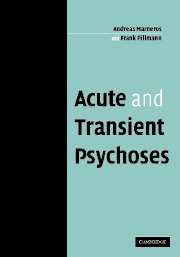Book contents
- Frontmatter
- Contents
- Preface
- Acknowledgements
- Part I History and concepts
- Part II Studies and findings
- Part III Issues of nosology
- 11 Defining the brief, acute and transient psychotic disorders: the polymorphic psychotic core
- 12 What are brief, acute and transient psychotic disorders?
- 13 Brief polymorphic psychoses as a component of a psychotic continuum
- References
- Index
12 - What are brief, acute and transient psychotic disorders?
from Part III - Issues of nosology
Published online by Cambridge University Press: 07 August 2009
- Frontmatter
- Contents
- Preface
- Acknowledgements
- Part I History and concepts
- Part II Studies and findings
- Part III Issues of nosology
- 11 Defining the brief, acute and transient psychotic disorders: the polymorphic psychotic core
- 12 What are brief, acute and transient psychotic disorders?
- 13 Brief polymorphic psychoses as a component of a psychotic continuum
- References
- Index
Summary
In the introduction to the present book, we compared the efforts of psychiatrists to define homogeneous groups of mental disorders with the work of a sculptor working with clay. Like the artist, who usually has to cut small, but also sometimes larger pieces of wood, marble or clay in an attempt to give material an identifiable feature, so the psychiatrist has to exclude smaller groups with ‘atypical’ features from the larger groups of ‘typical disorders’. But, the small atypical groups of mental disorders excluded from the large groups of typical disorders continue to exist; just as the left-over material of the sculpture which has been cut continues to exist – not as part of the sculpture, but rather as material left in the sculptor's workshop.
The creation by the WHO of the category F23 in the ICD-10 (i.e. the category ‘Acute and Transient Psychotic Disorder’) reflects the efforts of the psychiatrists to gather together parts of the excluded material remaining after forming the big category of schizophrenia – together with another uncertain mass, namely ‘schizoaffective disorder’. The DSM-IV group of ‘Brief Psychosis’ is, as we show, part of the ICD-10 Acute and Transient Psychotic Disorders category. Psychotic disorder with acute onset, short duration and usually dramatic polymorphic symptomatology – already described and classified within the framework of more or less national concepts in many countries – belong in this new category of ICD-10, as we pointed out in Chapters 1 and 2.
- Type
- Chapter
- Information
- Acute and Transient Psychoses , pp. 197 - 205Publisher: Cambridge University PressPrint publication year: 2004

